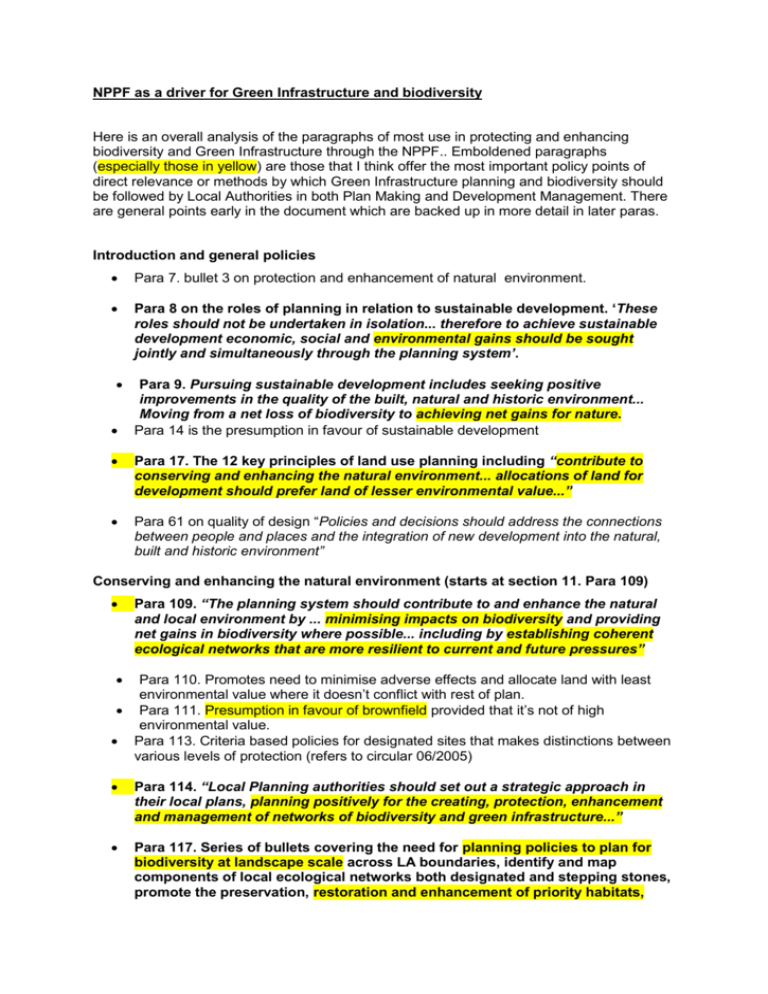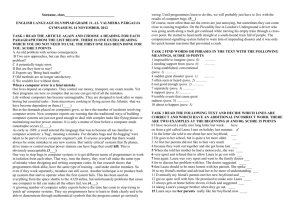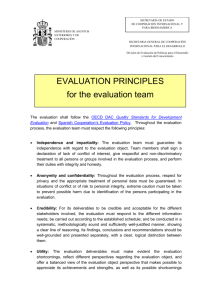NPPF Green Infrastructure and biodiversity for Worcester
advertisement

NPPF as a driver for Green Infrastructure and biodiversity Here is an overall analysis of the paragraphs of most use in protecting and enhancing biodiversity and Green Infrastructure through the NPPF.. Emboldened paragraphs (especially those in yellow) are those that I think offer the most important policy points of direct relevance or methods by which Green Infrastructure planning and biodiversity should be followed by Local Authorities in both Plan Making and Development Management. There are general points early in the document which are backed up in more detail in later paras. Introduction and general policies Para 7. bullet 3 on protection and enhancement of natural environment. Para 8 on the roles of planning in relation to sustainable development. ‘These roles should not be undertaken in isolation... therefore to achieve sustainable development economic, social and environmental gains should be sought jointly and simultaneously through the planning system’. Para 9. Pursuing sustainable development includes seeking positive improvements in the quality of the built, natural and historic environment... Moving from a net loss of biodiversity to achieving net gains for nature. Para 14 is the presumption in favour of sustainable development Para 17. The 12 key principles of land use planning including “contribute to conserving and enhancing the natural environment... allocations of land for development should prefer land of lesser environmental value...” Para 61 on quality of design “Policies and decisions should address the connections between people and places and the integration of new development into the natural, built and historic environment” Conserving and enhancing the natural environment (starts at section 11. Para 109) Para 109. “The planning system should contribute to and enhance the natural and local environment by ... minimising impacts on biodiversity and providing net gains in biodiversity where possible... including by establishing coherent ecological networks that are more resilient to current and future pressures” Para 110. Promotes need to minimise adverse effects and allocate land with least environmental value where it doesn’t conflict with rest of plan. Para 111. Presumption in favour of brownfield provided that it’s not of high environmental value. Para 113. Criteria based policies for designated sites that makes distinctions between various levels of protection (refers to circular 06/2005) Para 114. “Local Planning authorities should set out a strategic approach in their local plans, planning positively for the creating, protection, enhancement and management of networks of biodiversity and green infrastructure...” Para 117. Series of bullets covering the need for planning policies to plan for biodiversity at landscape scale across LA boundaries, identify and map components of local ecological networks both designated and stepping stones, promote the preservation, restoration and enhancement of priority habitats, ecological networks and protection and recovery of priority species populations linked to targets in the plan. Para 118. Key principles for biodiversity. Avoid, mitigates or compensate – otherwise refuse; no adverse effect on SSSIs either inside or outside the boundaries other than in exceptional circumstances; permit proposals with the main objective to conserve or enhance biodiversity; refuse applications leading to loss of irreplaceable habitats, esp woodland and veteran trees unless need outweighs loss. Para 119. International sites harm would not be sustainable. Other general policy guidance with an impact on biodiversity Para 125. Guidance on limiting the impacts of light pollution on nature conservation Para 143. Guidance on minerals restoration priorities including biodiversity. Para 144. Guidance on avoidance of harm to the natural environment through minerals planning decisions. Local Plans (begins at Para 150) Para 152. Local planning authorities should seek opportunities to achieve each of the economic, social and environmental dimension of sustainable development and net gains across all three. Also re-iterates commentary regarding the need for avoidance and mitigation of harm to any of the three pillars. Para 153. Supplementary documents should be used where they can help applicants make applications or bring forward infrastructure but should not increase financial burdens. Para 155. Early and meaningful collaboration with neighbourhoods, local organisations and businesses is essential. A wide section of the community should be engaged... so that local plans reflect a collective vision and agreed set of priorities. Para 156. Local authorities should set out strategic priorities for... conservation and enhancement of the natural environment. Para 157. Local plans should identify land where development would be inappropriate for instance because of its environmental significance. Plans should also contain a clear strategy for enhancing the natural, built and historic environment and supporting NIAs where they have been identified. Para 158. Plans should be based on up to date information about the natural (etc) environment. Para 165. Planning policies and decisions should be based on up-to-date information about the natural environment and other characteristics of the area including drawing, for example, from River Basin Management Plans. Working with Local Nature Partnerships where appropriate, this should include an assessment of existing and potential components of ecological networks. A sustainability appraisal which meets the requirements of the European Directive on strategic environmental assessment should be an integral part of the plan preparation process, and should consider all the likely significant effects on the environment, economic and social factors. Para 166. Local Plans may require a variety of other environmental assessments, including under the Habitats Regulations where there is a likely significant effect on a European wildlife site (which may not necessarily be within the same local authority area), Strategic Flood Risk Assessment and assessments of the physical constraints on land use On viability Para 176. Where safeguards are necessary to make a particular development acceptable in planning terms (such as environmental mitigation or compensation), the development should not be approved if the measures required cannot be secured through appropriate conditions or agreements. The need for such safeguards should be clearly justified through discussions with the applicant, and the options for keeping such costs to a minimum fully explored, so that development is not inhibited unnecessarily. On cross border duty. Para 180. Local planning authorities should take account of different geographic areas, including travel-to-work areas. In two tier areas, county and district authorities should cooperate with each other on relevant issues. Local planning authorities should work collaboratively on strategic planning priorities to enable delivery of sustainable development in consultation with Local Enterprise Partnerships and Local Nature Partnerships Decision Taking (DM policy begins at Para 186) Para 188. Early engagement has significant potential to improve the efficiency and effectiveness of the planning application system for all parties. Good quality preapplication discussion enables better coordination between public and private resources and improved outcomes for the community. Para 189. Local planning authorities have a key role to play in encouraging other parties to take maximum advantage of the pre-application stage Para 192. The right information is crucial to good decision-taking, particularly where formal assessments are required (such as Environmental Impact Assessment, Habitats Regulations Assessment and Flood Risk Assessment). To avoid delay, applicants should discuss what information is needed with the local planning authority and expert bodies as early as possible. CD Jan ‘13








